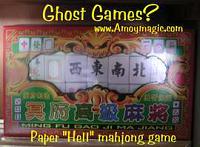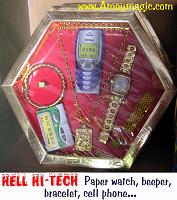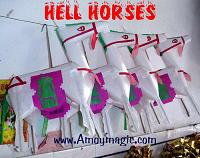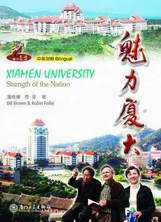![]() Click
to
Access
Click
to
Access
OUTSIDE China
![]() Click
to Access
Click
to Access
INSIDE
China ![]()
TRAVEL LINKS
![]() Xiamen
Xiamen
![]() Gulangyu
Gulangyu
![]() Jimei
Jimei
![]() Tong'an
Tong'an
![]() Jinmen
Jinmen
![]() Zhangzhou
Zhangzhou
![]() Quanzhou
Quanzhou
![]() Wuyi
Wuyi
![]() #1Fujian
Sites!
#1Fujian
Sites!
![]() Fujian
Foto Album
Fujian
Foto Album
![]() Books
on Fujian
Books
on Fujian
![]() Readers'Letters
Readers'Letters
![]() Ningde
Ningde
![]() Zhouning
Zhouning
![]() Longyan
Longyan
![]() Sanming
Sanming
![]() Putian
Putian
![]() Bridges
Bridges
![]() Travel
Info,
Travel
Info,
![]() Hakka
Roundhouses
Hakka
Roundhouses
![]() Travel
Agents
Travel
Agents
MISC. LINKS
![]() Amoy
People!
Amoy
People! ![]()
![]() Darwin
Driving
Darwin
Driving ![]()
![]() Amoy
Tigers
Amoy
Tigers
![]() Chinese
Inventions
Chinese
Inventions
![]() Tibet
in 80 Days!
Tibet
in 80 Days!![]()
![]() Dethroned!
Dethroned!
![]()
![]() Misc.Writings
Misc.Writings
![]() Latest
News
Latest
News
![]() Lord
of Opium
Lord
of Opium
![]() Back
to Main Page
Back
to Main Page
![]() Order
Books
Order
Books![]() Xiamenguide
Forum
Xiamenguide
Forum 
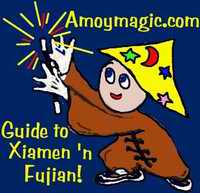
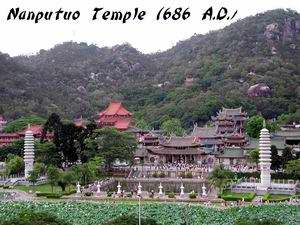 (ÄÏÆÕÍÓËÂ)
(ÄÏÆÕÍÓËÂ)
Click
Here for "Monk's Daily Schedule"
Nanputuo Buddhist monastery and temple, right
outside XMU¡¯s old gate, sprawls across the Five Old Man Mountains like
a Chinese miniature landscape on steroids, but it started out in 686 as
the humble cave dwelling of one monk.
Xi¨¤m¨¦n folk were in the throes of an unknown epidemic when Qin Hao arrived
on the scene. He settled down in a cave on a hillside blessed with medicinal
herbs. After his herbal brews saved the lives of many of the locals, they
begged him not to leave, so he stayed on and taught Buddhism.
That original cave is still there, but decorated beyond recognition, and
augmented by over 20 buildings, including the four axial halls: Heavenly
Emperor Hall (L¨ªngxi¨¡odi¨¤nÁèÏöµî), Heroic Treasure
Hall (D¨¤xi¨ngb¨£odi¨¤n´óÐÛ±¦µî), Great Benevolence
Hall (D¨¤b¨¥idi¨¤n´ó±¯µî), and Buddhist Scripture Repository
(Z¨¤ngj¨©ngg¨¦²Ø¾¸ó). Their scripture collection may be N¨¢np¨³tu¨®¡¯s
biggest claim to fame, with over 50,000 Buddhist scriptures¡ªa copy of
virtually every Chinese Buddhist scripture. They also have the oldest
Chinese Buddhist manuscript (translated about 2000 years ago).
N¨¢np¨³tu¨® is home to about 120 monks and a few hundred statues, including
the Revered Three-Life-Cycle Budda, the Four Heavenly Kings, the Eighteen
Arhats, and Bodhisattva, aka the Thousand Handed Guanyin (Qi¨¡nsh¨¯u Gu¨¡ngy¨©n
ǧÊÖ¹ÛÒô), and probably the patron saint of glove makers. Gu¨¡ny¨©n started
out as a man and ended up female; read about the ¡°Gu¨¡ny¨©n Temple later
in this chapter for details.
The Great Benevolence Hall is a 3-storey octagonal structure built by General Sh¨©l¨¤ng (Ê©ÀË) in 1684 after retaking T¨¢iw¨¡n from Koxinga¡¯s grandson. The roof, which is made entire of wooden beams and brackets (not one nail) has been noted by the Chinese Construction Ministry for its unique construction. The 1,000-handed Gu¨¡ny¨©n is composed of a sitting Gu¨¡ny¨©n and 3 standing Gu¨¡ny¨©ns. The standing Guanyins have two heads, a small one over the larger one (even the Chinese think two heads are better than one). The two-faced Guanyins face north, west and east.
Scripture
Repository & Holy Buddha Beads In addition to Buddhist
scriptures, the repository has former abbott¡¯s clothing, and such treasures
as a fine white porcelain Gu¨¡ny¨©n, a Qing Dynasty bronze bell, white
Jade Buddhas presented by Burma, Thailand, Sri Lanka, Cambodia and India,
and the ¡°Lotus Scriptures¡±, which were written in blood by monks about
500-600 years ago. The most unusual items are the ¡°holy cremation relics¡±¡ªhard,
pearl-like beads sifted from cremated saints¡¯ ashes. The beads embody
the saints¡¯ spiritual essence, and are said to have a beneficent effect
upon others. A Californian ¡°reported feeling that his molecules were
being rearranged in a more wholesome manner¡±). But what would you expect
from a Californian?
The downstairs Hall of Law is for meetings, and for disciplining monks
whose molecules, apparently, have yet to rearrange. But all disciplining
is done before Sakyamuni¡¯s statue to ensure fair play.
The
Merit Building, just inside the gate and to the right,
has wooden memorial tablets, for which relatives of the deceased pay 1000
Yuan each.
N¨¢np¨³tu¨® Vegetarian Restaurant,
in the P¨³zh¨¤o Bldg. (ÆÕÕÕ Â¥), behind the Merit Building, has served
famous veggies for a century. Read ¡°Veggie Tails¡± in the Restaurant
chapter to learn which dish D¨¨ng Xi¨£op¨ªng loved so much he had his
chef lug 200 pounds back to B¨§ij¨©ng (you¡¯ll also learn why you should
never, ever, eat taro with beef, because it is¡).
Buddhist Seminary¡ªinside the main gate, 2nd building on the left.
T¨¤ix¨± Library Ì«ÐéͼÊé¹Ý , completed in 1989, isbehind the seminary and has over 20,000 documents. A dozen monks and laypersons run the library, which is also open to lay Buddhists who obtain permission.
Monk
Pastimes What do monks do besides chant and study? Click
Here for the "Monk's Daily Schedule!"
South F¨²ji¨¤n Buddhist College
Started in 1925 by the abbot Huiquan, the college was closed after the
Japanese invaded in 1937, and re-opened in 1985. The college has four
departments: T¨¤ix¨± Library, editing department, monks¡¯ department and
nuns¡¯ department. Three departments are at N¨¢np¨³tu¨®, but the nuns¡¯
are cloistered separately in J¨©nb¨£ng Park (½ð°ñ¹«Ô°) near the train
station (see the Parks chapter). Modern monks are now allowed to leave
the monastery and have a wife, but while at N¨¢np¨³tu¨® they have nun.
None, I meant.
The college has 36 exalted-monk teachers, 110 monk students, and 6 graduate
students. During the 4-year program they study Buddhist scriptures and
rituals, humane studies, and Communist Party religious policies.
The nunnery at J¨©nb¨£ng Park is considerably larger, with 40 faculty,
250 undergrad students, 8 graduate students, and 4 overseas students.
Bruce Lee says the nuns study harder and write more articles than the
monks, even though they must keep the same strict schedule.
Merry
Maitreya
The pot-bellied Maitreya (M¨ªl¨¨f¨® ÃÖÀÕ·ð), ¡°god 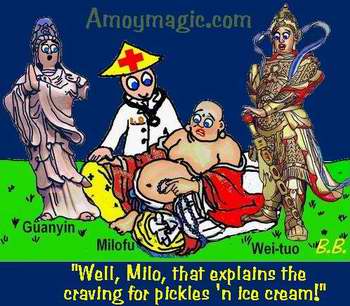 of
wealth,¡± greets N¨¢np¨³tu¨® visitors. Buddhism claims Sakyamuni, the
first Buddha, will rule 10,000 years. After international morality reaches
a high level, Buddhism will die out. Eight million years later, Maitreya
will come to preach. Let¡¯s hope Maitreya¡¯s sermons are shorter than
his prelude.
of
wealth,¡± greets N¨¢np¨³tu¨® visitors. Buddhism claims Sakyamuni, the
first Buddha, will rule 10,000 years. After international morality reaches
a high level, Buddhism will die out. Eight million years later, Maitreya
will come to preach. Let¡¯s hope Maitreya¡¯s sermons are shorter than
his prelude.
Maitreya last incarnated 1,000 years ago as the Linen-Bag Monk of Zh¨¨ji¨¡ng
(Õã½) Province. He traveled nonstop, preaching to all and sundry, free
from cares and smiling in all circumstances. He was convinced that he
was Maitreya incarnate, and so did everyone else¡ªat least after he died.
Behind Maitreya stands the Boddhisatva Skanda (W¨¦itu¨® ΤÍÓ), who safeguards
those two pillars of most religions: doctrine and finance. And W¨§itu¨®¡¯s
staff is why Nanputuo attracts so many pilgrims.
Tradition has it that when W¨¦itu¨® holds his staff horizontally in his
arms, he¡¯s suggesting, ¡°Try elsewhere.¡± But at N¨¢np¨³tu¨® W¨¦itu¨®¡¯s
staff is aimed at the ground, indicating the temple is wealthy and offers
both room and board. So pilgrims pack in by the hundreds of thousands.
And happily for this guardian of finance, they leave their millions behind
because Buddhists, quite literally, have money to burn¡
Money to Burn It¡¯s a good
thing Chinese invented paper or their extinguished ancestors wouldn¡¯t
have a chance in hell¡ªliterally! N¨¢np¨³tu¨® is always thronged with
pilgrims sacrificing paper houses, paper furniture, paper cars, even paper
microwaves, all of which are transmuted into the real thing for use in
the afterlife. I¡¯ve even seen paper air conditioners.
Leave it to Chinese to install A/C in hell.
Chinese also figure demons and deities can¡¯t tell real money from fake
so they print up trillions of dollars of ¡°Hell Money¡± on cheap paper
and for a few Yuan will sell a stack of Hell Money that could easily top
even Bill Gate¡¯s fortune.
It must make for some hellish inflation down below.
Demons, deities and dead ancestors get the short end of W¨§itu¨¡¯s stick
not just with money but munchies. A 15¡± deep basket of foods or fruits
may have a false bottom, with the lower 12¡± empty, because the folks
down downstairs can¡¯t tell the difference.
Click These Thumbnails for Larger Hellish Images!
The smoke of N¨¢np¨³tu¨®¡¯s eternal offerings may be especially fitting.
After all, China has 300 million smokers; maybe in hell they¡¯re smoking
paper tobacco? But given that Buddhism has 84,136 hells, I¡¯m not sure
if folks down there are smoking or being smoked. N¨¢np¨³tu¨®¡¯s studious
monks aren¡®t so sure either. I asked one, ¡°Who goes to Buddhism¡¯s 84,136
hells?¡±
He said, ¡°Anyone who does anything wrong.¡± He pondered this a bit, and
added with a wry smile, ¡°Everyone, I guess.¡±
¡°Is there a Buddhist heaven?¡± I asked.
¡°Of course,¡± he said.
¡°Who goes there?¡± I asked.
The monk thought a little, and said, ¡°Just a minute.¡± He pushed his
Gandhi spectacles back up on his nose, flipped back and forth through
the pages of a massive, musty volume, and after a few minutes said, ¡°No
one has ever asked me that. I¡¯ll have to get back to you.¡±
Devilish Deductions Gift
shops offer N¨¢np¨³tu¨® knickknacks like chant cassettes, glow-in-the-dark
plastic Buddhas, and wood or stone rosaries. But don¡¯t try to pay with
Hell Money or there really will be hell to pay. And unlike American religious
merchandising, there¡¯s no ¡°Suggested love offering¡±, or tax deductible
receipt. But given the state of Buddhist hells¡¯ economic affairs, you
can probably just add a few zeros to your receipt and make an outlandish
deduction after you die.
The Infernal Revenue Service will never know the difference.
Moneychangers in the Temple N¨¢np¨³tu¨®¡¯s real excitement is not inside the temple grounds but outside the massive gates, where street vendors cry, ¡°Candied crab apples on a stick!¡± and ¡°Fresh sliced pineapple!¡± and ¡°Tea eggs 3 mao (cents) each or 2.50 a jin¡± (a jin is about 1.1 pounds). Shoe repairpersons from far off S¨¬chu¨¡n resurrect weary pilgrims¡¯ weary soles with glue and thread, and T¨®ng¡¯¨¡n peasants puff rice with a coal-fired cast iron contraption that goes off like a cannon every few minutes. The liveliest trade, of course, is in Buddhist paraphernalia¡ªincense sticks, candles, ¡°Hell Bank Notes.¡± And until recently there was another trade that struck me as a bit fishy¡
Freeing
Captive Fish Pond
Buddhists are vegetarians, in theory at least, and opposed to taking any
kind of life (though enterprising peasants may enjoy beef ¡®n green pepper,
guilt-free, after arranging for a calf to strangle itself on a short leash).
If there is merit in not taking life, there is even greater merit in saving
it, so pious pilgrims used to buy live fish from markets and free the
finned folk from their dire fate by dumping them into the 1000m2 N¨¢np¨³tu¨®¡¯s
Captive Fish Pond.
But given that this went on day and night for decades, how did one pond
hold so many fish? I suspected the monks financed their Nokia cell phones
by recycling the fish, who probably had more lives than my cats. I think
this practice has stopped at N¨¢np¨³tu¨®, but it continues at most temples
big enough to have a pond.
Nanputuo Address: Just outside XMU Old Gate
Tel: 5855113 www.nanputuo.com
A Bang and a Whimper N¨¢np¨³tu¨®¡¯s
endless emancipation of captive carp went on largely in silence, but not
so the other activities. Monks drive off devils, both domestic and foreign,
by banging drums and cymbals day and night. And before Xi¨¤m¨¦n banned
fireworks, the temple grounds emanated an eternal cacophony of firecrackers
that reverberated off the adjoining XMU Foreign Expert¡¯s Guesthouse walls,
and the denizen¡¯s pounding craniums.
Chinese have been enamored of fireworks since before the dawn of recorded
time 5,018 years ago. They shooed demons by burning bamboo stems, which
explode when air heats up in the hollows between the joints. Somewhere
down the line, an enterprising soul stuffed the bamboo with gunpowder,
and eventually someone replaced the bamboo with rolls of heavy paper,
giving us the modern fireworks we hear today¡ªor used to hear.
During the mid 1990s, a stroke of the pen banned this perennial pastime
in many major cities. Now Chinese shoot off their fireworks in the countryside
and small towns, or pop strings of balloons, or play tape recordings of
firecrackers over massive sound systems. The ambiance just ain¡¯t the
same.
TRAVEL
LINKS  Favorite
Fujian Sites
Favorite
Fujian Sites  Fujian
Foto Album
Fujian
Foto Album  Xiamen
Xiamen
 Gulangyu
Gulangyu
 Fujian
Guides
Fujian
Guides  Quanzhou
Quanzhou
 Zhangzhou
Zhangzhou
 Longyan
Longyan
 Wuyi
Mtn
Wuyi
Mtn  Ningde
Ningde
 Putian
Putian
 Sanming
Sanming
 Zhouning
Zhouning
 Taimu
Mtn.
Taimu
Mtn.  Roundhouses
Roundhouses
 Bridges
Bridges
 Jiangxi
Jiangxi
 Guilin
Guilin
 Order
Books
Order
Books
 Readers'
Letters
Readers'
Letters
Last Updated: May 2007
![]()
DAILY
LINKS
![]() FAQs
Questions?
FAQs
Questions?
![]() Real
Estate
Real
Estate
![]() Shopping
Shopping
![]() Maps
Maps
![]() Bookstores
Bookstores
![]() Trains
Trains
![]() Busses
Busses
![]() Car
Rental
Car
Rental
![]() Hotels
Hotels
![]() News
(CT)
News
(CT)
![]() Medical
& Dental
Medical
& Dental
![]() YMCA
Volunteer!
YMCA
Volunteer! ![]()
![]() XICF
Fellowship
XICF
Fellowship
![]() Churches
Churches
![]()
![]()
![]() Temples
Temples![]()
![]() Mosque
Mosque
![]() Expat
Groups
Expat
Groups
![]() Maids
Maids
![]() Phone
#s
Phone
#s
EDUCATION
![]() Xiamen
University
Xiamen
University
![]() XIS(Int'l
School)
XIS(Int'l
School)
![]() Study
Mandarin
Study
Mandarin
![]() CSP(China
Studies)
CSP(China
Studies)
![]() Library
Library
![]() Museums
Museums
![]() History
History
DINING
![]() Restaurants
Restaurants
![]() Asian
Asian
![]() Veggie
Veggie
![]() Junk
Food
Junk
Food
![]() Chinese
Chinese
![]() Italian
Italian
![]() International
International![]()
![]() Visas
4 aliens
Visas
4 aliens
RECREATION
![]() Massage!
Massage!
![]() Beaches
Beaches
![]() Fly
Kites
Fly
Kites
![]() Sports
Sports
![]() Boardwalk
Boardwalk
![]() Parks
Parks
![]() Pets
Pets
![]() Birdwatching
Birdwatching
![]() Kung
Fu
Kung
Fu ![]() Hiking
Hiking
![]() Music
Events
Music
Events
![]() Festival&Culture
Festival&Culture
![]() Humor&
Humor&![]() Fun
Fotos
Fun
Fotos![]()
BUSINESS
![]() Doing
Business
Doing
Business
![]() Jobs!(teach/work)
Jobs!(teach/work)
![]() Hire
Workers
Hire
Workers
![]() Foreign
Companies
Foreign
Companies
![]() CIFIT
(Trade Fair)
CIFIT
(Trade Fair)
![]() MTS(Translation)
MTS(Translation)
![]()
Back to Top




